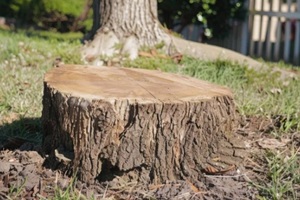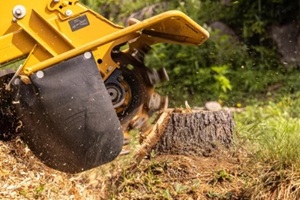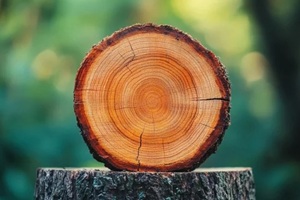
Tree removal is a major decision that should be carefully considered and planned. After a tree is cut down, the leftover stump can create safety concerns, attract insects and fungal growth, and interfere with future landscaping or construction plans. Professional removal of a stump can help mitigate these problems by personalizing the removal process for the needs of the property.
This brief guide walks property owners through the main steps of the professional stump removal process to allow for an informed decision. Although professionals handle all elements of the process, property owners should be aware of expectations as a result of the removal.
Regardless of whether tree trimming, stump removal, replanting, or other steps are required, local professionals can help property owners prioritize the health and beauty of their landscapes in Northern Virginia.
1. Initial Assessment
The first step in the professional stump removal process is for the arborist to visit the property and evaluate the issue. This will include examining the stump, measuring it, assessing its species and condition, and identifying potential challenges related to the structure or the surrounding landscape. This assessment should include:
- Measuring the access and distance between the stump and surrounding structures, including sidewalks, buildings, and fences
- Inquiring about or inspecting nearby underground utilities
- Identifying the species of tree
- Checking for diseases, including pest infestations, fungal growths, and more
- Checking for wood rot
- Inspecting surrounding plants, noting their distance from the stump
- Assessing the soil condition
Many properties in Northern Virginia are filled with dense, mature trees. A professional tree service should create a site-specific plan to remove the stump while protecting nearby infrastructure. While a stump may be a potential cause for disease or infestation, removing it without the proper precautions could damage the integrity of the landscape.
2. Decide Whether the Stump Should Be Removed
Whether a tree falls or needs to be removed, stump removal may seem like the only option. However, stump grinding also exists, allowing experienced arborists to take a different approach when full removal could damage the landscape. Property owners will have to understand the pros and cons of each before beginning the process.
Benefits of Stump Grinding
Stump grinding uses specialized machines to grind the stump down into chips, typically stopping 6-12 inches below the soil level. One of the benefits of grinding instead of removing is that the root system will be left to naturally decay and leave the soil and structures around the stump undisturbed.
Stump grinding tends to be more affordable since it requires less equipment and landscaping. It is a common choice for residential property owners with limited access, resources, or seeking preservation of landscape in certain situations.
Benefits of Stump Removal

Despite these benefits, excavating the entire stump, including the root ball, may be advantageous or even necessary in many cases. To plant a new tree in the same spot or prepare the spot for a construction project, full stump removal is often a more practical option. An experienced arborist can help property owners decide which stump removal method makes the most sense based on their landscape and future plans.
3. Prepare the Site
Once a method has been chosen, the site needs to be prepared for stump removal. This involves marking the locations of underground utilities, clearing out debris and furniture from the area, and shielding nearby plants. The removal team and their equipment must be able to access the site as well, so access gates may need to be temporarily removed.
4. Remove the Stump
The process of removal differs depending on the method chosen. For grinding, the steps are as follows:
- The technician positions the grinder
- The cutting wheel rotates, chipping the outer layers of the stump
- As grinding continues, the chips are collected or left on site, depending on the needs of the owner
- Once ground to the desired depth, chips or soil can be used to fill the hole
For full removal, the steps are different:
- Depending on the depth or type of stump, hand tools or machine excavators are used to dig around the stump and loosen the roots
- Once loosened, the stump can be lifted and removed, including the root ball
- Machines are used to backfill the hole with soil
Regardless of the method used, most residential stump removals can be completed in a few hours. Property owners who plan to re-establish trees or plants, or start a construction project in the stump’s former location should communicate with their arborists to make sure the site is ready to accommodate their project.
5. Aftercare
Once the stump has been removed, the professional tree care team will begin the cleanup process. This includes raking the area, leveling it off, removing wood chips or redistributing them on the property, and applying top soil. Property owners who plan on reseeding and replanting the area can ask their arborist for a soil test and aftercare advice on the types of plants and trees that would flourish on their landscape.
Partner with Experienced Arborists for Stump Removal Services in Northern Virginia

Choosing between stump removal and grinding can be difficult for property owners in Alexandria and around Northern Virginia, many of whom have mature tree growth in the vicinity, post-storm property damage, construction projects, or landscaping plans. At RTEC Treecare, our experienced arborists help residential and commercial property owners create the best stump removal strategy for the health and beauty of their landscape.
Contact our experienced team for stump removal, tree trimming, or other tree services. Our certified arborists use a preservation-focused approach to match the process to the landscape and make sure that the property can be maintained even after we’re gone.


